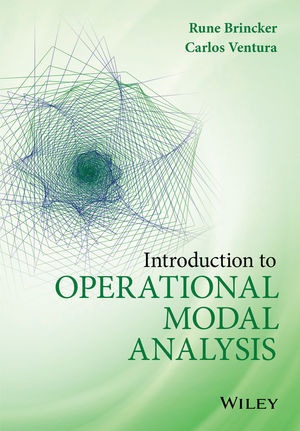Read more
Provides all the information an engineer will require to set up an operational modal test. The first book dedicated to operational modal analysis (OMA) and authored by a pioneer in the field, Introduction to Operational Modal Analysis provides all the information an engineer will require to set up an operational modal test.
List of contents
Preface xi
1 Introduction 1
1.1 Why Conduct Vibration Test of Structures? 3
1.2 Techniques Available for Vibration Testing of Structures 3
1.3 Forced Vibration Testing Methods 4
1.4 Vibration Testing of Civil Engineering Structures 5
1.5 Parameter Estimation Techniques 5
1.6 Brief History of OMA 6
1.7 Modal Parameter Estimation Techniques 6
1.8 Perceived Limitations of OMA 10
1.9 Operating Deflection Shapes 10
1.10 Practical Considerations of OMA 11
1.11 About the Book Structure 13
References 15
2 Random Variables and Signals 17
2.1 Probability 17
2.1.1 Density Function and Expectation 17
2.1.2 Estimation by Time Averaging 19
2.1.3 Joint Distributions 21
2.2 Correlation 23
2.2.1 Concept of Correlation 23
2.2.2 Autocorrelation 24
2.2.3 Cross Correlation 25
2.2.4 Properties of Correlation Functions 27
2.3 The Gaussian Distribution 28
2.3.1 Density Function 28
2.3.2 The Central Limit Theorem 28
2.3.3 Conditional Mean and Correlation 30
References 31
3 Matrices and Regression 33
3.1 Vector and Matrix Notation 33
3.2 Vector and Matrix Algebra 35
3.2.1 Vectors and Inner Products 35
3.2.2 Matrices and Outer Products 36
3.2.3 Eigenvalue Decomposition 38
3.2.4 Singular Value Decomposition 40
3.2.5 Block Matrices 40
3.2.6 Scalar Matrix Measures 41
3.2.7 Vector and Matrix Calculus 43
3.3 Least Squares Regression 44
3.3.1 Linear Least Squares 44
3.3.2 Bias, Weighting and Covariance 47
References 52
4 Transforms 53
4.1 Continuous Time Fourier Transforms 53
4.1.1 Real Fourier Series 54
4.1.2 Complex Fourier Series 55
4.1.3 The Fourier Integral 58
4.2 Discrete Time Fourier Transforms 59
4.2.1 Discrete Time Representation 59
4.2.2 The Sampling Theorem 62
4.3 The Laplace Transform 66
4.3.1 The Laplace Transform as a generalization of the Fourier Transform 66
4.3.2 Laplace Transform Properties 67
4.3.3 Some Laplace Transforms 68
4.4 The Z-Transform 71
4.4.1 The Z-Transform as a generalization of the Fourier Series 71
4.4.2 Z-Transform Properties 73
4.4.3 Some Z-Transforms 73
4.4.4 Difference Equations and Transfer Function 75
4.4.5 Poles and Zeros 76
References 79
5 Classical Dynamics 81
5.1 Single Degree of Freedom System 82
5.1.1 Basic Equation 82
5.1.2 Free Decays 83
5.1.3 Impulse Response Function 87
5.1.4 Transfer Function 89
5.1.5 Frequency Response Function 90
5.2 Multiple Degree of Freedom Systems 92
5.2.1 Free Responses for Undamped Systems 93
5.2.2 Free Responses for Proportional Damping 95
5.2.3 General Solutions for Proportional Damping 95
5.2.4 Transfer Function and FRF Matrix for Proportional Damping 96
5.2.5 General Damping 99
5.3 Special Topics 107
5.3.1 Structural Modification Theory 107
5.3.2 Sensitivity Equations 109
5.3.3 Closely Spaced Modes 110
5.3.4 Model Reduction (SEREP) 114
5.3.5 Discrete Time Representations 116
5.3.6 Simulation of OMA Responses 119
References 121
6 Random Vibrations 123
6.1 General Inputs 123
6.1.1 Linear Systems 123
About the author
Rune Brincker is a civil engineer and received his M.Sc and Ph.D. from the Technical University of Denmark in 1977 and 1981, respectively. Since then he has been conducting research on various aspects of structural mechanics. Rune has been employed as associate and full professor at several Danish universities. Presently he is a Professor of Structural Dynamics at Aarhus University, Denmark. During the last 30 years his research has been focused on operational modal analysis (OMA), and one of his major contributions to this field has been the development of the frequency domain decomposition (FDD) identification technique, which has been used in many practical applications of OMA. Rune Brincker is a co-founder of Structural Vibration Solutions (SVS) founded in 1999; and he is the founding chair of the International Operational Modal Analysis Conference (IOMAC) which started in 2005.
Carlos Ventura is a Civil Engineer with specializations in structural dynamics and earthquake engineering. He has been a faculty member of the Department of Civil Engineering at the University of British Columbia (UBC) in Canada since 1992. He is currently the Director of the Earthquake Engineering Research Facility (EERF) at UBC, and is the author of more than 450 papers and reports on earthquake engineering, structural dynamics and modal testing. He has conducted research about earthquakes and structural dynamics for more than thirty years. In addition to his academic activities, Carlos Ventura is a recognized international consultant on structural vibrations and safety of large Civil Engineering structures. He is a member of the Canadian Academy of Engineering and Fellow of Engineers Canada, also a member of several national and international professional societies, advisory committees and several building and bridge code committees.
Summary
The first book dedicated to operational modal analysis (OMA) and authored by a pioneer in the field, this resource provides the information an engineer needs to set up an operational modal test.

